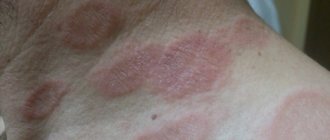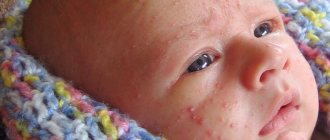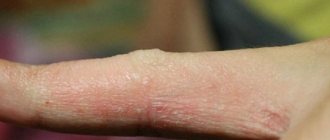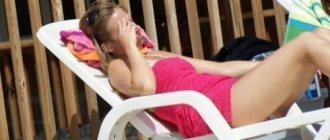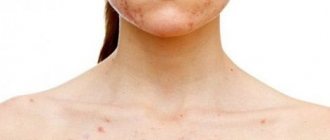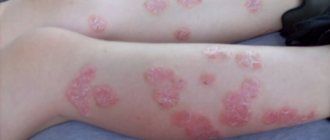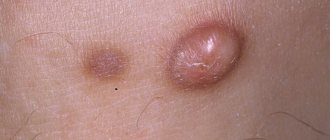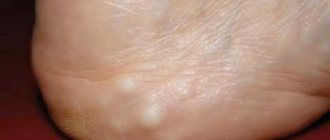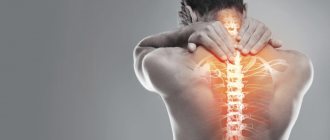In the structure of foot skin diseases, eczema occupies one of the leading places. It is one of the most common types of allergic dermatosis. According to specialist research, the number of cases is constantly growing. The clinical picture of dermatosis is the same, the features are determined only by the stage and severity of the disease.
Eczema is an inflammatory disease of the skin layers, which is characterized by a recurrent and persistent course without long-term remissions. The manifestation of external signs causes serious inconvenience and negatively affects the patient’s quality of life.
Skin affected by eczema
Classification and characteristic features
Eczema of the skin of the legs is the most common. Depending on the nature of the damage to the skin, several types are distinguished.
Dry eczema on legs
Types of eczema
True (idiopathic) eczema
It is expressed in symmetrical lesions of the skin with unclear boundaries. Alternates diseased and healthy areas - “groups of islands”. Itching of varying intensity appears. During the transition to the acute stage, vesicles form, hyperemia, weeping “serous wells” and serous crusts appear. As the condition worsens, a secondary rash (lichenification) appears and cracks form. Idiopathic eczema is divided into:
- dyshidrotic - the surfaces of the feet are affected;
- tylotic (horny) - on the feet and between the toes;
- pruriginous - manifests itself on the bends of the knees and ankles;
- cracked - the lesions are located in the lower leg area.
Microbial
It manifests itself as asymmetrical purulent lesions that are covered with crusts. The boundaries of the affected areas are clear, with a “border” of exfoliating epidermis. Along the periphery there are separate foci and purulent crusts. This type of eczema is accompanied by intense itching. Types of microbial eczema:
- paratraumatic;
- coin-shaped (nummular) - with localization of lesions in the lower leg area;
- varicose veins - on the surfaces of the lower leg and ankle joints.
Professional
This eczematous reaction is also called occupational allergic dermatitis. This disease appears as a result of systematic contact of the skin with substances that irritate it in industrial conditions.
Children's
Atopic dermatitis manifests itself in the form of symmetrical hyperemic lesions with unclear boundaries. The skin is swollen, and weeping “wells” with crusts appear. Accompanied by severe itching.
Stages of development
According to the stages of development, eczema on the legs is divided into:
- erymatous;
- papular;
- vesicular;
- getting wet;
- crusty;
- squamous.
Each stage can occur acutely, subacutely and chronically.
Folk remedies
An inexpensive and effective way to treat eczema are ointments prepared from natural ingredients at home. The basic components of such products are plant extracts, among which are:
- coltsfoot flowers;
- dandelion root;
- birch buds and leaves;
- series;
- plantain;
- nettle;
- thousand-headed pyramidal.
These medicinal plants have anti-inflammatory, wound-healing and softening activity, accelerating the process of regeneration of damaged tissues.
Treatment with folk remedies is limited by the condition of the skin - in the presence of purulent wounds, their use is not recommended.
The preparation of the ointment is carried out in two stages:
- Preparation of herbal extract
. Fresh ingredients (50 g of any 5 herbs) are ground through a meat grinder or blender to a paste. The finished mixture is carefully squeezed into an opaque container. - Mixing components
. As a base for the ointment, use regular Vaseline or badger fat. 100 g of base is added to the herbal extract and mixed thoroughly until smooth. The finished mass is tightly sealed and stored in the refrigerator for no more than 10 days.
An ointment based on herbal extract is applied to damaged skin in the form of applications, up to 3 times a day. If the stratum corneum is very dense and dry, first make a warm foot bath. The maximum course is 14 days, further treatment is performed after a break. It is recommended to use self-prepared ointments in combination with pharmaceutical preparations.
Initial signs and symptoms of development
Early changes always begin with redness of the skin area, accompanied by sharp swelling, slight burning and itching in the affected area.
Weeping eczema on legs
With further development of the disease, a rash appears in the form of vesicles or nodules. When the vesicles open, surfaces with serous fluid (“wells”) are formed, on which crusts appear. Itching and burning intensify, painful sensations may appear, causing great inconvenience to the person. Due to deformation and rupture of capillaries, damaged skin has a dark red or bluish color. If left untreated, leg eczema can develop into a chronic form of the disease.
Zinc ointment
Particular attention should be paid to a drug that has been used for a long time and provides truly effective treatment. Zinc ointment for eczema has an astringent, antimicrobial and antiseptic effect. It is used to treat all types of eczema, especially suitable for patients with wet eczema; in this case, the ointment helps dry out the weeping areas and prevents the infection from spreading further. The ointment is applied to the skin with the affected areas in a thin layer. Preferably 3-4 times a day. Since it has no contraindications, it can be used during pregnancy and children from infancy. If used for wet eczema, the result will be in a week: the skin will dry out, itching, burning, redness and irritation will disappear. The only point in which the use of zinc ointment is not recommended is increased sensitivity to the drug and purulent rashes.
Zinc ointment, a safe and affordable remedy for eczema
Diagnostics
A preliminary diagnosis of eczema is made by a dermatologist based on the first visual examination and identification of symptoms. Upon further questioning of the patient, the factors that served as the impetus for the manifestations of the disease are clarified. The laboratory performs immunological tests for allergens, urine and blood tests, the results of which provide a final diagnosis.
If it is necessary to exclude diseases with similar symptoms, a biopsy is performed to determine the histology of the affected skin, as well as microscopic examinations and a detailed blood test.
The effectiveness of ointments for eczema
The therapeutic effect of external medications against eczematous processes on the lower extremities depends on the nature and depth of local morphological elements. Serous and exudative rashes, complicated by the development of secondary infectious inflammation, require longer use of ointments or the use of additional drugs.
Since the skin on the legs has a stratum corneum, treatment requires preliminary softening (baths, poultices). The effectiveness of local drugs is much higher for a child than for an adult patient, since in childhood there is no pronounced keratinization of the skin.
Do something useful, it won't take much time
source
Treatment for eczema at home
When treating eczema, complex therapy is used, including:
- medications;
- use of ointments;
- traditional methods (infusions, herbal baths, lotions, wraps);
- physiotherapy.
In order to prevent the disease during the period of remission, it is necessary to care for the skin of the legs and feet with special moisturizers.
Skin care
The main requirement for moisturizing preventive preparations is their hypoallergenicity. To avoid allergic reactions, it is recommended to use products based on lactate, glycerin and urea. The lipids included in the preparations restore the protective water barrier on the surface of the skin, and hydrophilic substances retain moisture in deeper layers. For dry skin on the heels, soles and legs, it is preferable to use moisturizing milk with 5% urea content.
Diet
In addition to the medications and treatment methods described above, the patient is recommended to adhere to a diet high in protein, limit the consumption of fats, carbohydrates, and table salt. It is necessary to consume no more than 1200 ml of liquid per day. You need to add more vegetables, fruits and dairy products to your daily diet.
Pharmacy assistants in the fight against disease
At the first stage of the fight against the disease, it is necessary to eliminate the provoking factor and alleviate acute manifestations, as well as carry out comprehensive treatment of concomitant diseases.
Calcium gluconate
10% calcium gluconate is prescribed as daily intramuscular injections of 5.0 or 10.0 ml. The drug helps restore calcium levels in the body and also acts as a neutralizer for possible allergic reactions caused by medications. In addition to injections, it can be taken in powder or tablet form before meals. The dosage of the medicine is prescribed by the doctor.
Enterosorbents
Disturbances in the functioning of the kidneys, liver and gastrointestinal tract play a very important role in the manifestation of eczema symptoms. This leads to the accumulation of a large number of toxins, which aggravate the clinical picture. To cleanse the body, sorbents are prescribed that remove all toxins, poisons, medication residues, food allergens and neutralize pathogenic bacteria in the intestines.
Glucocorticosteroids
Highly active topical corticosteroids have a pronounced anti-inflammatory and antifungal effect. Local use of medications helps relieve discomfort in the affected areas of the skin and organs. The duration of the course of treatment is 2 – 3 weeks. Prolonged and uncontrolled use of glucocorticosteroids can cause undesirable reactions in the form of cosmetic skin defects, as well as exacerbation or relapse of dermatosis.
Antihistamines
Antihistamines are widely used in the treatment of leg eczema. By blocking histamine receptors, they;
- quickly relieve itching, swelling and redness of the skin;
- reduce the number of antibodies and the concentration of class A immunoglobulins;
- weaken the spasmogenic effect of histamine.
These medications do not change the biochemical analysis of blood and urine, do not affect blood pressure and heart function, the concentration of sugar and cholesterol in the blood, and also do not have a depressing effect on the central nervous system.
Vitamins
Vitamin and antioxidant complexes during exacerbation of dermatosis have a positive effect on blood vessels, the immune system and enhance the effect of antihistamines.
Sedatives
To normalize the function of the central nervous system, sedatives are prescribed. They eliminate anxiety, fear, nervous tension, restlessness, irritability and emotional instability.
Immunomodulators
When treating microbial eczema, you cannot do without immunomodulatory agents. They support and stimulate the body's defenses, helping to reduce treatment time and increasing the period of remission between exacerbations of chronic dermatosis.
Treatment for eczema on feet, fingers and toenails
Therapy for eczema involves the use of local and general medications. Treatment is comprehensive and only under the supervision of the attending physician. To begin with, it is important to determine the factor that provoked the development of the pathology, then the doctor selects treatment methods.
For treatment, hardware methods are prescribed:
- cryotherapy;
- phototherapy;
- electrophoresis;
- laser irradiation.
A course of the following medications is also prescribed:
- enterosorbents;
- vitamin and mineral complexes;
- immunostimulants;
- corticosteroid anti-inflammatory;
- sedatives;
- antihistamines;
- antibacterial, antifungal, antiviral;
- calcium preparations.
The use of hormonal and non-hormonal ointments is possible:
| Hormonal | Prednisol. The course of treatment is 14 days. The ointment has pronounced side symptoms. Before use, it is important to familiarize yourself with the contraindications. |
| Hydrocortisone ointment. Suitable for treating severe eczema to quickly suppress it. Prescribed only by a doctor. Use strictly according to instructions. | |
| Soderm. Belongs to the group of corticosteroid drugs. After several uses of the ointment, the symptoms of itching and pain go away. It is distinguished by the presence of certain contraindications. | |
| Non-hormonal | Aurobin – suitable for treating early stages of eczema. Promotes rapid restoration of damaged dermis. |
| Dermasan is an effective remedy for eczema, but has many contraindications. | |
| Skin-Cap is one of the most effective ointments. It can also be used to combat infectious pathogens. Has virtually no side effects. The course of treatment is at least 14 days. |
It is strictly not recommended to select medications on your own. Self-medication can not only aggravate the problem, but also cause many serious complications!
Traditional medicine against eczema of the feet
With complex therapy, in addition to medications, eczema can be treated with folk remedies. Poultices, ointments, infusions and decoctions are made using herbs and plants. They help relieve itching, inflammation, and accelerate the regeneration of skin tissue.
For example, a decoction and ointment from celery root help fight dermatitis, and compresses relieve itching. Alcohol tincture of ginger root is an excellent immunomodulator. Aloe juice applications have a calming, restorative, anti-inflammatory and wound-healing effect. The use of celandine for eczema of the legs will neutralize the effect of pathogenic bacteria, fungi and microorganisms.
Celery
It is important to remember that there is always the possibility of individual intolerance to drugs. Before using traditional medicine, you should consult with your doctor to prevent worsening of the disease.
General indications for use
Despite the fact that the disease can occur for various reasons, complex therapy includes standard treatment. To eliminate the symptoms of the pathology, dermatologists prescribe a cream or ointment for eczema on the body and hands. To achieve the desired effect, it is necessary to select a drug that fully meets certain requirements.
An effective ointment should:
- eliminate burning, itching;
- act as a protective, reliable barrier that prevents the penetration of pathogenic bacteria;
- have a moisturizing effect on the epithelium;
- be completely harmless to humans.
In most cases, ointment for eczema on the body and face has the following indications:
- itching on the skin, burning;
- inflammatory rashes;
- dryness and hyperemia.
Important! If the symptoms of the disease are pronounced and localized on the neck, facial skin or folds, it is better to use an eczema cream that has a moderate or mild effect. To treat dry dermatitis, a topical medicine on a thick base is suitable. If such drugs are poorly tolerated, treatment of eczema on the hands should be carried out using a cream with a delicate texture (containing glycerin or starch). Oily solutions containing vitamins E and A will help eliminate weeping wounds.

